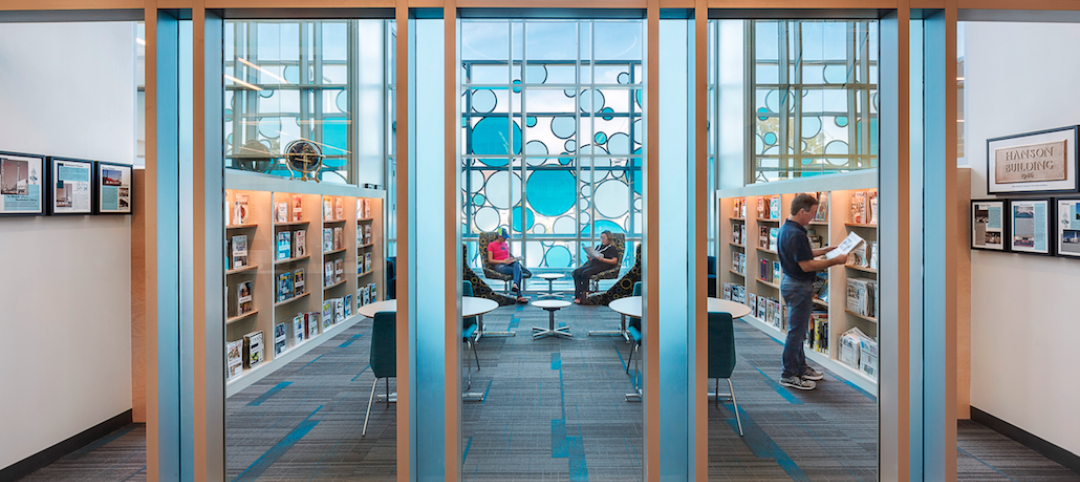From pearlescent and iridescent coatings to highly accurate color-matching tools to programmable, color-changing LED lights, color is taking on a bigger and increasingly high-tech role on building projects.
The widespread growth of colorized materials—from metal wall and roof panels to glass and glazing systems, to metal mesh assemblies—and the availability of custom colors across a broad range of product lines have provided architects and designers with almost limitless options for exterior and interior design projects.
Technology tools like 3D modeling software and color-matching apps have taken much of the guesswork out of evaluating colors and color palettes for building design projects. And advances in manufacturing—from new textile printing methods to novel coating formulations—are leading to breakthroughs in hues, patterns, textures, and special effects in colorized materials and finishes.
Given the “color craze” in architecture, it is no surprise that most design professionals believe that color plays a more-critical role in today’s building design projects than those from a decade ago.
Findings from BD+C's 2020 Color Trends Report
Two-thirds of architects, interior designers, and color experts surveyed between December 2019 and March 2020 by Building Design+Construction for the 2020 Color Trends Survey said that color on design projects (interior spaces and exterior design) is more important today than it was a decade ago. And fewer than 2% believe color is less important.
The growth in demand for color in the commercial, institutional, and multifamily building sectors is being driven by several converging trends. For one, clients are more willing to accept risk and variation on their projects, according to survey respondents.
“Especially for interiors, the story told by a color palette is crucial to creating an experience that can be differentiated from the norm,” said one architect respondent.
The rising cost of materials and construction is another important consideration: “Color is one of the easiest ways to add impact for the least amount of cost, thus more important today with the rising costs of everything.”
The final PDF report of BD+C's 2020 Color Trends Survey includes data on:
- Innovations in color and colorized materials
- Specification trends in color and colorized materials
- Source of color expertise and inspiration in design firms
- The importance of color on today's building projects (interior and exterior applications)
- The importance of color in 2020 vs. 2010
- Reasons for the change in the importance of color on building projects
- Use of special effect coatings
- Biggest innovations in color related to interior or exterior building design
Download the 2020 Color Trends Survey report (short registration required)
Special thanks to Sherwin-Williams Coil Coatings
for their support of this BD+C editorial research project.
More at coil.sherwin.com.
Related Stories
Architects | Aug 21, 2017
AIA: Architectural salaries exceed gains in the broader economy
AIA’s latest compensation report finds average compensation for staff positions up 2.8% from early 2015.
Sports and Recreational Facilities | Aug 18, 2017
Video: Designing the ideal rugby stadium
HOK invited four world-class rugby players into its London studio to discuss what they would like to see in the rugby stadiums of the future.
Architects | Aug 16, 2017
Staffelbach joins DLR Group
The firm will be merging operations immediately with full integration and the name change to DLR Group| Staffelbach effective October 2.
Multifamily Housing | Aug 9, 2017
Related Companies unveils plans for One Hudson Yards luxury rental residences
The 33-story tower will be positioned on the High Line with views of the Hudson River and downtown Manhattan.
Multifamily Housing | Aug 9, 2017
Multifamily developers, designers cater to occupants’ need for mobility
Bike storage facilities and “bicycle kitchens” are among the most popular mobility amenities in multifamily developments, according to a new survey by Multifamily Design + Construction magazine.
Giants 400 | Aug 9, 2017
Innovation at 72 design firms
The following is a list of advancements architecture and A/E firms underwent in 2016, as reported in Building Design+Construction's 2017 Giants 300 Report.
Giants 400 | Aug 9, 2017
Top 115 Architecture Firms
Gensler, Perkins+Will, and HKS top Building Design+Construction’s ranking of the nation’s largest architecture firms, as reported in the 2017 Giants 300 Report.
Giants 400 | Aug 9, 2017
Top 100 Architecture/Engineering Firms
Stantec, HOK, and CallisonRTKL are among the nation’s largest architecture/engineering firms, according to Building Design+Construction’s 2017 Giants 300 Report.
Contractors | Aug 4, 2017
4 ways to prepare for a negotiation
Practice, practice, practice, and understanding both sides of the deliberation are critical to success in any negotiation.


















